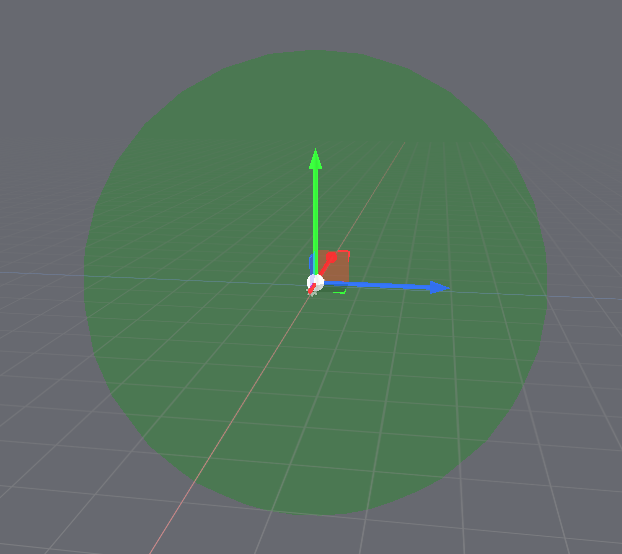Gizmos
Intermediate Programmer
Gizmos are a tool which you can implement over your components to provide visual assistance for designers when manipulating component values.
Here's an exhaustive example one could implement:
using Stride.Core;
using Stride.Core.Mathematics;
using Stride.Engine;
using Stride.Engine.Gizmos;
using Stride.Graphics;
using Stride.Graphics.GeometricPrimitives;
using Stride.Rendering;
using Stride.Rendering.Materials;
using Stride.Rendering.Materials.ComputeColors;
// We will be implementing a Gizmo for the following class
public class MyScript : StartupScript
{
}
// This attribute specifies to the engine that the following gizmo class is bound to 'MyScript',
// the game studio will pick that up and spawn an instance of that class for each 'MyScript' in the scene
[GizmoComponent(typeof(MyScript), isMainGizmo:false/*When true, only the first gizmo on an entity with true is visible, false means that it is always visible*/)]
public class Gizmo : IEntityGizmo
{
private bool _selected, _enabled;
private MyScript _component;
private ModelComponent _model;
private Material _material, _materialOnSelect;
// This property is set based on whether the gizmo is globally turned on or off in the editor's view settings
public bool IsEnabled
{
get
{
return _enabled;
}
set
{
_enabled = value;
_model.Enabled = _enabled;
}
}
// The size slider value in the view settings pane
public float SizeFactor { get; set; }
// The editor will set this property whenever the entity the component is on is selected
public bool IsSelected
{
get
{
return _selected;
}
set
{
_selected = value;
_model.Materials[0] = _selected ? _materialOnSelect : _material;
// The logic below shows gizmos for all components when they are on in the gizmo settings, and when off, only shows the one from the selected entity
// Removing the line hides gizmos even when selected when the gizmo settings is off
_model.Enabled = _selected || _enabled;
}
}
// This constructor is called by the editor,
// A gizmo class MUST contain a constructor with a single parameter of the component's type
public Gizmo(MyScript component)
{
_component = component;
}
public bool HandlesComponentId(OpaqueComponentId pickedComponentId, out Entity? selection)
{
// This function is called when scene picking/mouse clicking in the scene on a gizmo
// The engine calls this function on each gizmos, gizmos in term notify the engine
// when the given component comes from them by returning true, and provide the editor with the corresponding entity this gizmo represents
if (pickedComponentId.Match(_model))
{
selection = _component.Entity;
return true;
}
selection = null;
return false;
}
public void Initialize(IServiceRegistry services, Scene editorScene)
{
// As part of initialization, we create a model in the editor scene to visualize the gizmo
var graphicsDevice = services.GetSafeServiceAs<IGraphicsDeviceService>().GraphicsDevice;
// In our case we'll just rely on the GeometricPrimitive API to create a sphere for us
// You don't have to create one right away, you can delay it until the component is in the appropriate state
// You can also dynamically create and update one in the Update() function further below
var sphere = GeometricPrimitive.Sphere.New(graphicsDevice);
var vertexBuffer = sphere.VertexBuffer;
var indexBuffer = sphere.IndexBuffer;
var vertexBufferBinding = new VertexBufferBinding(vertexBuffer, new VertexPositionNormalTexture().GetLayout(), vertexBuffer.ElementCount);
var indexBufferBinding = new IndexBufferBinding(indexBuffer, sphere.IsIndex32Bits, indexBuffer.ElementCount);
_material = Material.New(graphicsDevice, new MaterialDescriptor
{
Attributes =
{
Emissive = new MaterialEmissiveMapFeature(new ComputeColor(new Color4(0.25f,0.75f,0.25f,0.05f).ToColorSpace(graphicsDevice.ColorSpace))) { UseAlpha = true },
Transparency = new MaterialTransparencyBlendFeature()
},
});
_materialOnSelect = Material.New(graphicsDevice, new MaterialDescriptor
{
Attributes =
{
Emissive = new MaterialEmissiveMapFeature(new ComputeColor(new Color4(0.25f,0.75f,0.25f,0.5f).ToColorSpace(graphicsDevice.ColorSpace))) { UseAlpha = true },
Transparency = new MaterialTransparencyBlendFeature()
},
});
_model = new ModelComponent
{
Model = new Model
{
(_selected ? _materialOnSelect : _material),
new Mesh
{
Draw = new MeshDraw
{
StartLocation = 0,
// You can swap to LineList or LineStrip to show the model in wireframe mode, you'll have to adapt your index buffer to that new type though
PrimitiveType = PrimitiveType.TriangleList,
VertexBuffers = new[] { vertexBufferBinding },
IndexBuffer = indexBufferBinding,
DrawCount = indexBuffer.ElementCount,
}
}
},
RenderGroup = IEntityGizmo.PickingRenderGroup, // This RenderGroup allows scene picking/selection, use a different one if you don't want selection
Enabled = _selected || _enabled
};
var entity = new Entity($"{nameof(Gizmo)} for {_component.Entity.Name}"){ _model };
entity.Transform.UseTRS = false; // We're controlling the matrix directly in this case
entity.Scene = editorScene;
vertexBuffer.DisposeBy(entity);
indexBuffer.DisposeBy(entity); // Attach buffers to the entity for manual disposal later
}
public void Dispose()
{
_model.Entity.Scene = null;
_model.Entity.Dispose(); // Clear the two buffers we attached above
}
public void Update()
{
// This is where you'll update how the gizmo looks based on MyScript's state
// Here we'll just ensure the gizmo follows the entity it is representing whenever that entity moves,
// note that UseTRS is disabled above to improve performance and ensure that there are no world space issues
_model.Entity.Transform.LocalMatrix = _component.Entity.Transform.WorldMatrix;
}
}
And the result:

Do note that you may have to restart the editor if it was open while you introduced this new gizmo.